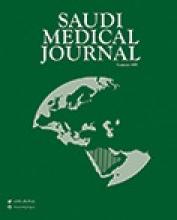Abstract
OBJECTIVE: Hepatic artery thrombosis after liver transplantation is uncommon, but represents an important cause of morbidity and mortality. The aim of this study is to identify the possible risk factors for the development of hepatic artery thrombosis, and the impact of hepatic artery thrombosis on the patients and graft survival.
METHODS: Between January 1994 and June 1998, we reviewed retrospectively a series of 86 liver transplant procedures performed on 81 adult patients. Arterial anomalies of the donor graft, rejection episodes, cold ischemia time, ABO matching, the use of blood/fresh frozen plasma during and after surgery, and the use of heparin as prophylactic anticoagulation therapy were examined as a possible contributing risk factors for the development of hepatic artery thrombosis.
RESULTS: Hepatic artery thrombosis occurred in 7 procedures out of 86 (9%). Early cases of Hepatic artery thrombosis within 15 days after transplant occurred in 4 patients. Late thrombosis occurred in 3 patients. Analysis of potential risk factors for the development of hepatic artery thrombosis was carried out. Five out of 40 patients who did not received prophylactic heparin had hepatic artery thrombosis (12.5%), while only 2 out of 46 patients who received prophylactic heparin had hepatic artery thrombosis 4%. On the other hand, 6 out of the 7 patients developed hepatic artery thrombosis received more than 5 units of blood transfusion during the transplant procedure (11%) while only one patient developed hepatic artery thrombosis who received less than 5 units intra-operatively (3%). Management of hepatic artery thrombosis cases were carried out in the form of: thrombectomy (n=1), thrombectomy followed by retransplantation (n=2), and non-surgical or conservative treatment (n=4). The overall survival rate was (43%) (3 out of 7). Out of four deaths, 3 were directly related to hepatic artery thrombosis while the cause of death iin the remaining patients was attributed to pulmonary sepsis.
CONCLUSION: Early hepatic artery thrombosis leads to death unless quick retransplantation follows. Conservative treatment for the late onset hepatic artery thrombosis on occasion has been useful. The use of postoperative prophylactic anticoagulation therapy might be of benefit in the prevention of hepatic artery thrombosis after liver transplantation. Increased transfusion requirement for red blood cells during transplant procedure was independently associated with increase incidence of hepatic artery thrombosis.
- Copyright: © Saudi Medical Journal
This is an open-access article distributed under the terms of the Creative Commons Attribution-Noncommercial-Share Alike 3.0 Unported, which permits unrestricted use, distribution, and reproduction in any medium, provided the original work is properly cited.






